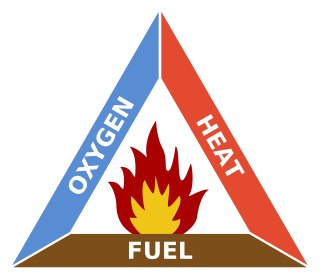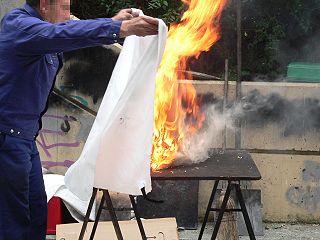
Deep frying is a cooking method in which food is submerged in hot fat, traditionally lard but today most commonly oil, as opposed to the shallow frying used in conventional frying done in a frying pan. Normally, a deep fryer or chip pan is used for this; industrially, a pressure fryer or vacuum fryer may be used. Deep frying may also be performed using oil that is heated in a pot. Deep frying is classified as a hot-fat cooking method. Typically, deep frying foods cook quickly since oil has a high rate of heat conduction and all sides of the food are cooked simultaneously.

Pan frying or pan-frying is a form of frying food characterized by the use of minimal cooking oil or fat, typically using just enough to lubricate the pan. In the case of a greasy food such as bacon, no oil or fats may need to be added. As a form of frying, the technique relies on oil or fat as the heat transfer medium, and on correct temperature and time to not overcook or burn the food. Pan frying can serve to retain the moisture in foods such as meat and seafood. The food is typically flipped at least once to ensure that both sides are cooked properly.
Saponification is a process of cleaving esters into carboxylate salts and alcohols by the action of aqueous alkali. Typically aqueous sodium hydroxide solutions are used. It is an important type of alkaline hydrolysis. When the carboxylate is long chain, its salt is called a soap. The saponification of ethyl acetate gives sodium acetate and ethanol:

A convection oven is an oven that has fans to circulate air around food to create an evenly heated environment. In an oven without a fan, natural convection circulates hot air unevenly, so that it will be cooler at the bottom and hotter at the top than in the middle. Fan ovens cook food faster, and are also used in non-food, industrial applications. Small countertop convection ovens for household use are often marketed as air fryers.

Firefighting is a profession aimed at controlling and extinguishing fire. A person who engages in firefighting is known as a firefighter or fireman. Firefighters typically undergo a high degree of technical training. This involves structural firefighting and wildland firefighting. Specialized training includes aircraft firefighting, shipboard firefighting, aerial firefighting, maritime firefighting, and proximity firefighting.

A deep fryer is a kitchen appliance used to cook foods by full immersion in hot oil ”. The cooking oil are typically between temperatures of 350 to 375 °F.

A turkey fryer is an apparatus for deep-frying a turkey. Fried turkey has been a popular item in the Southern United States, and has become popular in other parts of the country because of the reduced time needed to cook a turkey in a deep fryer, versus other conventional methods such as an oven or a rotisserie grill.

Fire control is the practice of reducing the heat output of a fire, reducing the area over which the fire exists, or suppressing or extinguishing the fire by depriving it of fuel, oxygen, or heat. Fire prevention and control is the prevention, detection, and extinguishment of fires, including such secondary activities as research into the causes of fire, education of the public about fire hazards, and the maintenance and improvement of fire-fighting equipment.

A fire blanket is a safety device designed to extinguish incipient (starting) fires. It consists of a sheet of a fire retardant material that is placed over a fire in order to smother it.

The following outline is provided as an overview of and topical guide to the preparation of food:
A fire class is a system of categorizing fire with regard to the type of material and fuel for combustion. Class letters are often assigned to the different types of fire, but these differ between territories; there are separate standards for the United States, Europe (DIN EN2 Classification of fires ISO3941 Classification of fires, and Australia. The fire class is used to determine the types of extinguishing agents that can be used for that category.
A vacuum fryer is a deep-frying device housed inside a vacuum chamber. With vacuum frying it is easier to maintain natural colors and flavours of the finished product. Due to the lower temperatures applied, the formation of suspected carcinogen acrylamide is significantly lower than in standard atmospheric fryers, where the frying temperature is approximately 170 °C (338 °F). The fat absorption of the products is also reported to be lower than in atmospheric fryers. In Southeast Asia batch type vacuum fryers are mainly used for the production of fruit chips. However, these machines are only appropriate for relatively small production companies.

A fire extinguisher is a handheld active fire protection device usually filled with a dry or wet chemical used to extinguish or control small fires, often in emergencies. It is not intended for use on an out-of-control fire, such as one which has reached the ceiling, endangers the user, or otherwise requires the equipment, personnel, resources or expertise of a fire brigade. Typically, a fire extinguisher consists of a hand-held cylindrical pressure vessel containing an agent that can be discharged to extinguish a fire. Fire extinguishers manufactured with non-cylindrical pressure vessels also exist but are less common.
The use of a cutting extinguisher is a fire extinguishing technique that combines abrasive waterjet cutting with water spray extinguishing, through a single handpiece or nozzle. The fire-fighter approaches the fire from outside the main fire area, then uses the cutting action to drill a small hole through a door or wall. Switching to a water spray then allows the fire to be fought, as with a conventional fog nozzle.
A thermal burn is a type of burn resulting from making contact with heated objects, such as boiling water, steam, hot cooking oil, fire, and hot objects. Scalds are the most common type of thermal burn suffered by children, but for adults thermal burns are most commonly caused by fire. Burns are generally classified from first degree up to fourth degree, but the American Burn Association (ABA) has categorized thermal burns as minor, moderate, and major, based almost solely on the depth and size of the burn.

Frying is the cooking of food in oil or another fat. Similar to sautéing, pan-fried foods are generally turned over once or twice during cooking to make sure that the food is evenly cooked, using tongs or a spatula, whilst sautéed foods are cooked by "tossing in the pan". A large variety of foods may be fried.

Triple-cooked chips are a type of chips developed by the English chef Heston Blumenthal. The chips are first simmered, then cooled and drained using a sous-vide technique or by freezing; deep fried at 130 °C (266 °F) and cooled again; and finally deep-fried again at 180 °C (356 °F). The result is what Blumenthal calls "chips with a glass-like crust and a soft, fluffy centre".

Cooking oil is a plant or animal liquid fat used in frying, baking, and other types of cooking. Oil allows higher cooking temperatures than water, making cooking faster and more flavorful, while likewise distributing heat, reducing burning and uneven cooking. It sometimes imparts its own flavor. Cooking oil is also used in food preparation and flavoring not involving heat, such as salad dressings and bread dips.

A French fry vending machine is a vending machine that dispenses hot French fries, also known as chips. The first known French fry vending machine was developed circa 1982 by the defunct Precision Fry Foods Pty Ltd. in Australia. A few companies have developed and manufactured French fry vending machines and prototypes. Furthermore, a prototype machine was also developed at Wageningen University in the Netherlands.

In fire classes, a Class B fire is a fire in flammable liquids or flammable gases, petroleum greases, tars, oils, oil-based paints, solvents, lacquers, or alcohols. For example, propane, natural gas, gasoline and kerosene fires are types of Class B fires. The use of lighter fluid on a charcoal grill, for example, creates a Class B fire. Some plastics are also Class B fire materials.





















